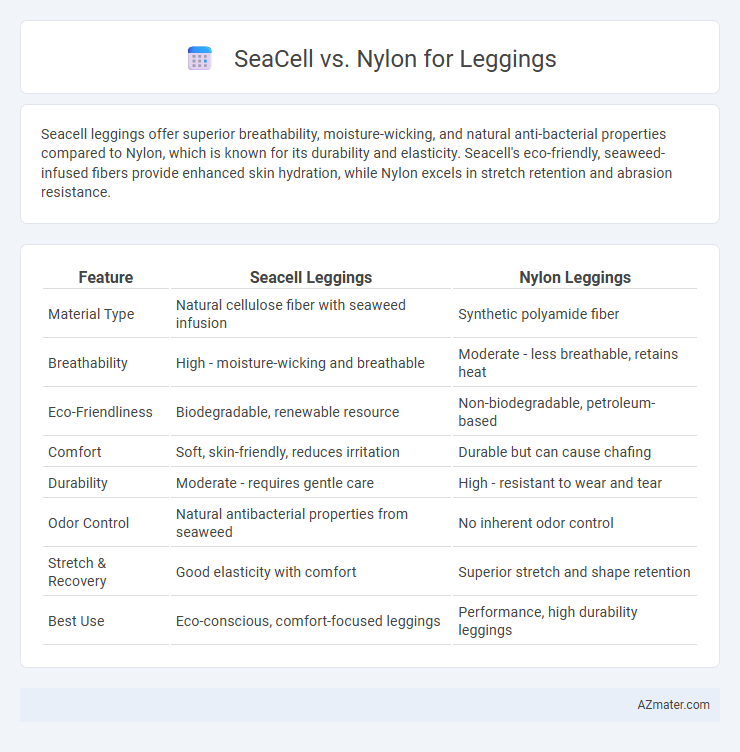Seacell leggings offer superior breathability, moisture-wicking, and natural anti-bacterial properties compared to Nylon, which is known for its durability and elasticity. Seacell's eco-friendly, seaweed-infused fibers provide enhanced skin hydration, while Nylon excels in stretch retention and abrasion resistance.
Table of Comparison
| Feature | Seacell Leggings | Nylon Leggings |
|---|---|---|
| Material Type | Natural cellulose fiber with seaweed infusion | Synthetic polyamide fiber |
| Breathability | High - moisture-wicking and breathable | Moderate - less breathable, retains heat |
| Eco-Friendliness | Biodegradable, renewable resource | Non-biodegradable, petroleum-based |
| Comfort | Soft, skin-friendly, reduces irritation | Durable but can cause chafing |
| Durability | Moderate - requires gentle care | High - resistant to wear and tear |
| Odor Control | Natural antibacterial properties from seaweed | No inherent odor control |
| Stretch & Recovery | Good elasticity with comfort | Superior stretch and shape retention |
| Best Use | Eco-conscious, comfort-focused leggings | Performance, high durability leggings |
Seacell vs Nylon: An Overview
Seacell leggings offer superior breathability and natural moisture-wicking properties compared to nylon, making them ideal for sensitive skin and active wear. Nylon provides excellent durability and elasticity, ensuring a snug fit and resistance to abrasion, but lacks the biocompatible benefits found in Seacell fabrics. Choosing between Seacell and nylon depends on prioritizing eco-friendly, skin-soothing materials versus high-performance stretch and longevity.
Material Composition and Origins
Seacell leggings are crafted from a blend of cellulose fibers derived from sustainably harvested seaweed and natural cotton, providing biodegradable and skin-friendly properties rich in antioxidants. Nylon leggings are made from synthetic polyamide fibers produced through petrochemical processes, offering durability and elasticity but lacking biodegradability. The natural origin and eco-friendly benefits of Seacell contrast with the synthetic nature and environmental impact of nylon in activewear fabric choices.
Comfort and Feel: Seacell vs Nylon
Seacell leggings offer superior softness and natural breathability due to their cellulose fiber content, providing a smooth, skin-friendly feel that reduces irritation during prolonged wear. Nylon leggings excel in durability and moisture-wicking properties, delivering a sleek, lightweight fit that supports active movement while maintaining shape. Choosing Seacell prioritizes comfort and eco-friendly softness, whereas nylon emphasizes resilience and performance.
Moisture-Wicking and Breathability Comparison
Seacell leggings offer superior moisture-wicking properties due to the incorporation of natural seaweed fibers that actively absorb sweat and promote quick evaporation, enhancing comfort during intense workouts. Nylon leggings provide strong durability and moderate breathability but tend to retain moisture longer, which can lead to discomfort in high-sweat activities. The breathable structure of Seacell fibers facilitates better airflow compared to the denser nylon fabric, making it ideal for extended wear and temperature regulation.
Durability and Longevity
Seacell leggings offer superior durability due to their natural fibers enhanced with seaweed extracts, which resist wear and maintain fabric integrity over time. Nylon leggings provide excellent strength and elasticity, making them highly durable for active use, but they may degrade faster with repeated washing and exposure to heat. For longevity, Seacell blends promote sustained fabric softness and biodegradability, whereas nylon is known for its long-lasting stretch and resilience under mechanical stress.
Environmental Impact and Sustainability
Seacell leggings are crafted from biodegradable fibers derived from sustainably harvested seaweed, promoting a lower carbon footprint and reducing reliance on petrochemical resources. Nylon leggings, made from synthetic polymers, contribute to microplastic pollution and require significant energy during production, raising environmental concerns. Choosing Seacell over Nylon supports eco-friendly fashion by enhancing biodegradability and minimizing oceanic and landfill waste.
Skin Health and Hypoallergenic Properties
Seacell leggings, made from cellulose fibers infused with seaweed, offer natural skin benefits such as moisturizing and anti-inflammatory properties, promoting healthier skin. Nylon leggings, while durable and stretchy, may sometimes cause irritation or allergic reactions for sensitive skin due to synthetic material composition. Seacell is generally favored for its hypoallergenic qualities and ability to support skin health, making it a better choice for those with sensitivities or skin concerns.
Performance in Activewear Applications
Seacell leggings offer superior moisture-wicking and natural antibacterial properties, making them ideal for high-intensity workouts by keeping the skin dry and odor-free. Nylon leggings excel in durability and stretch recovery, providing excellent shape retention and resistance to abrasion during rigorous training. Both materials enhance activewear performance, but Seacell prioritizes comfort and skin health, while nylon emphasizes longevity and support.
Care and Maintenance Differences
Seacell leggings require gentle washing with cold water and mild detergent to preserve their natural seaweed fibers, while nylon leggings are more durable and can usually withstand warm water and machine washing. Seacell fabric benefits from air drying to maintain its softness and avoid fiber damage, whereas nylon leggings dry quickly and are typically safe for tumble drying on low heat. Proper care extends the lifespan of both materials but Seacell demands more delicate handling to retain its eco-friendly properties compared to the resilient nature of nylon.
Choosing the Best Material for Leggings
Seacell leggings offer superior moisture-wicking and natural antibacterial properties, making them ideal for active wear and sensitive skin. Nylon leggings excel in durability, elasticity, and a smooth finish, providing long-lasting comfort and shape retention. Choosing the best material depends on prioritizing Seacell's eco-friendly, skin-nourishing benefits or Nylon's strength and stretch for high-performance leggings.

Infographic: Seacell vs Nylon for Legging
 azmater.com
azmater.com